How to Get B2B Leads With 7 Proven Tactics
November 6, 2025
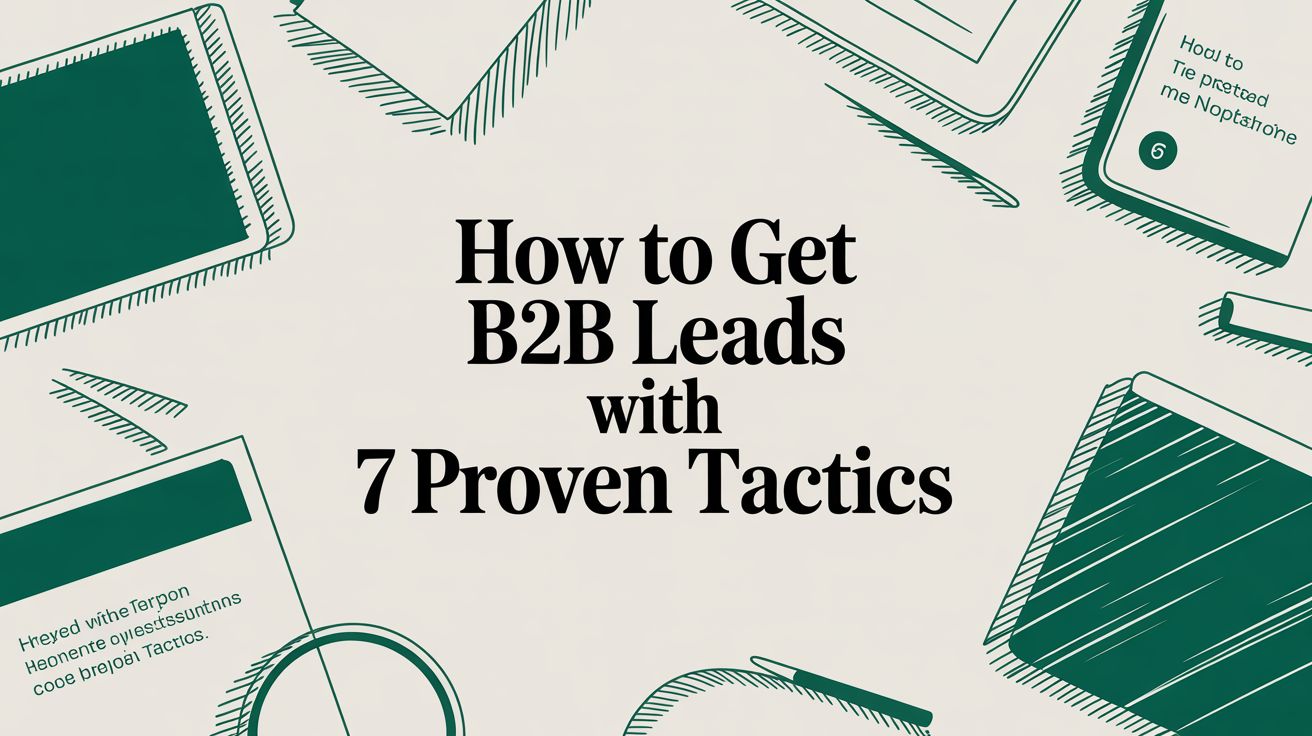
Generating high-quality B2B leads doesn't start with a flashy new tactic. It starts with a quiet, foundational understanding of who you're selling to and what problems you actually solve for them. It’s about building a precise Ideal Customer Profile (ICP) and a compelling value proposition before you even think about outreach channels.
This initial work is, without a doubt, the most critical step in creating a predictable stream of genuine opportunities.
Build Your Foundation for High-Quality B2B Leads
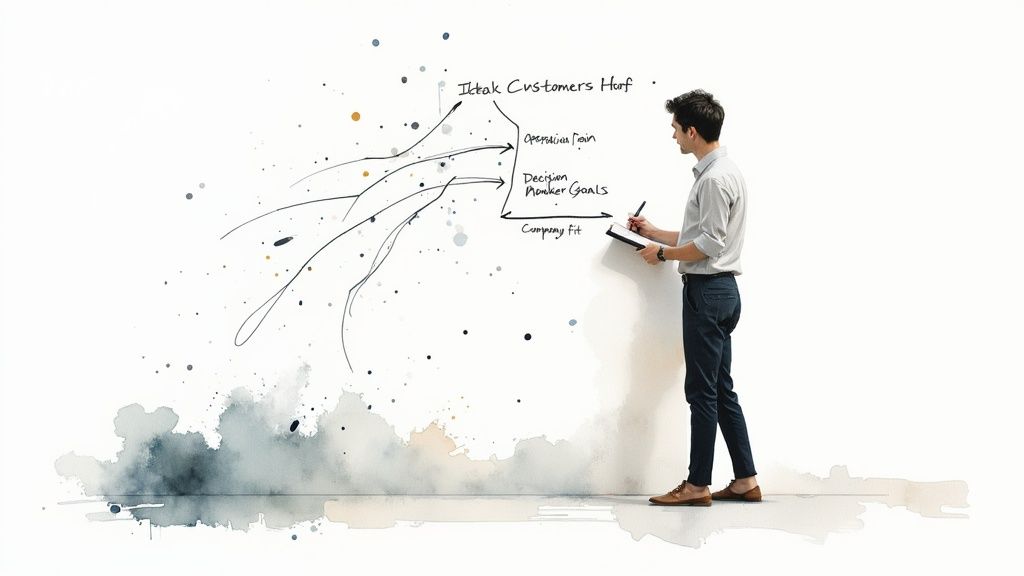
Many B2B companies dive headfirst into cold emailing or pouring money into social media ads without a clear direction, only to wonder why their efforts fall flat. The reason is almost always a weak foundation. Before you can effectively find B2B leads, you have to define exactly who you’re trying to reach and give them a rock-solid reason to care.
This process goes way beyond basic demographics like company size or industry. A truly powerful foundation is built on deep empathy and a granular, real-world understanding of your ideal customer's world.
Define Your Ideal Customer Profile
Think of your Ideal Customer Profile (ICP) as the blueprint for your entire lead generation engine. It’s a detailed, living description of the perfect-fit company for your product or service. A vague ICP leads to wasted time and resources chasing prospects who were never going to buy.
To build an ICP that actually works, get specific and answer these questions:
- Firmographics: What are the basic company stats? (Think industry, annual revenue, employee count, and geographical location.)
- Technographics: What technologies are they already using? (This could be their CRM, marketing automation platform, or specific software stacks.)
- Operational Pains: What specific, day-to-day operational headaches are they dealing with that your solution directly solves? Get into the nitty-gritty here.
- Business Goals: What are their bigger objectives? (Are they trying to increase efficiency by 20%, slash customer churn, or break into a new market?)
For instance, a project management software company might define their ICP as a "50-200 person software development agency in North America that uses Jira but struggles with client-facing reporting and budget tracking." See how specific that is? This is the level of detail that turns a generic persona into a sharp, actionable targeting tool.
For a deeper dive, check out our in-depth article on how to identify target markets for B2B to really refine your approach.
Craft a Value Proposition That Resonates
Once you know who you're targeting, you need to articulate why they should give you a moment of their time. Your value proposition is a clear, compelling statement that explains the tangible, real-world results a customer gets from using your product. It’s the heart of all your messaging.
A strong value proposition isn't about what your product does; it's about what your customer achieves. It should speak directly to the pains and goals you uncovered in your ICP research.
Instead of a generic statement like, "We offer a cloud-based analytics platform," a much stronger value proposition would be, "We help marketing directors at SaaS companies cut their customer acquisition costs by 30% by identifying their most profitable channels."
This message is specific, outcome-focused, and connects directly to a key business objective. With a clear ICP and a powerful value proposition in hand, every single lead generation activity you undertake becomes more effective and more targeted.
Master LinkedIn for a Consistent B2B Lead Flow
Let’s be honest: LinkedIn is no longer just a place to park your resume. For B2B companies, it’s the single most powerful engine available for generating leads. But the old "connect and immediately pitch" method is dead. If that’s your strategy, you’re just creating noise.
Real success on LinkedIn comes from a fundamental mindset shift. You have to stop acting like a vendor and start behaving like a trusted advisor. This means building genuine authority and creating a magnetic presence that pulls prospects to you, long before you ever ask for a sale.
Build Authority Through Valuable Content
Forget about posting for the sake of posting. Your content needs a clear, singular purpose: to solve the specific, nagging problems of your Ideal Customer Profile. The goal is to become the go-to resource in your niche—the first person prospects think of when they hit a roadblock.
Start by sharing your unique perspective on what’s happening in your industry. Don’t write a novel; create short, scannable posts that offer genuinely actionable advice. A B2B SaaS founder could share a quick video on the top three mistakes early-stage companies make when choosing a CRM. Simple, direct, and valuable.
This approach builds trust and positions you as an expert who helps, not just sells. When you consistently deliver insights, you earn the right to be heard. You can find a much deeper dive on this in our complete guide to B2B LinkedIn marketing right here: https://www.bigmoves.marketing/blog/b2b-linkedin-marketing.
Engage Authentically in Niche Communities
Your ideal customers are already gathered in LinkedIn Groups, talking about their biggest challenges and looking for answers. This isn’t an opportunity to sell; it’s an opportunity to listen and engage. Find the groups where your people hang out and become an active, contributing member.
- Answer questions thoughtfully. Don’t just drop a one-liner. Provide detailed, helpful answers without even mentioning your product.
- Share relevant articles. Post insightful third-party content that you know will spark a good discussion.
- Participate in conversations. Add your unique perspective to ongoing debates and discussions. Be a real voice, not a billboard.
By offering value without any expectation, you build incredible credibility. Prospects will naturally click on your profile to figure out who this helpful person is, turning a completely cold interaction into a warm inbound lead.
Don't just join groups—become part of the community fabric. Authentic engagement is about giving way more than you take. When you establish yourself as a helpful and knowledgeable presence, the leads will follow.
Harness the Power of LinkedIn Advertising
While your organic efforts are building that long-term authority, LinkedIn's advertising tools can generate immediate interest. Specifically, LinkedIn Lead Gen Forms are an absolute game-changer for capturing high-intent prospects with almost zero friction.
These forms pre-populate with a user's profile information, making it ridiculously easy for them to hand over their details. This streamlined experience is a huge reason why 89% of B2B marketers use LinkedIn for lead generation, and a staggering 62% find it highly effective.
Think about this: LinkedIn Lead Gen Forms can hit conversion rates as high as 13%. That completely blows past the typical landing page average of just 2.35%.
Here’s a look at how a sponsored content ad can feature a direct call-to-action that opens one of these forms.

This is what a seamless lead capture looks like. You're removing all the usual barriers, making it simple for interested people to raise their hand and say, "Tell me more."
Now, if you really want to take things to the next level, you can combine these paid strategies with proactive outreach. For a look at some of the most advanced techniques, you should definitely dive into these modern prospecting strategies on LinkedIn.
By blending a strong content foundation with smart advertising and targeted outreach, you can transform LinkedIn into a predictable, scalable, and high-quality source of B2B leads.
Develop an Omnichannel Outreach System That Works
Relying on a single channel to get B2B leads is like trying to catch rain with a thimble—you’ll get a few drops, but you’ll miss the downpour. Your prospects aren’t living in just one place; they’re bouncing between their inbox, social feeds, and a dozen other platforms all day. A modern outreach system has to mirror that reality by creating a seamless, coordinated experience across multiple touchpoints.
The point isn't just to be everywhere. It's about making each interaction build on the last, turning a series of separate messages into a single, cohesive conversation. This is how you stop being another piece of noise and start being a relevant voice they actually want to hear from.
Connect Your Channels Intelligently
A real omnichannel strategy isn't about blasting the same generic message across email, LinkedIn, and Twitter at the same time. That’s just multichannel spam. Instead, it’s about creating a logical flow where each channel has a specific job, all working together to guide the prospect.
Here’s what this looks like in the real world:
- Initial Touchpoint (LinkedIn): You spot a target prospect posting an interesting article about challenges in their industry. Instead of jumping in with a pitch, you leave a thoughtful comment that actually adds to the conversation.
- Second Touchpoint (Email): A few days later, you send a personalized email. Now you have a natural opener: "I enjoyed your recent post on LinkedIn about [Topic]. It got me thinking about how companies like yours are tackling [Problem]."
- Third Touchpoint (Content): Your email doesn't immediately ask for a meeting. Instead, it offers something valuable, like a high-impact case study or a short video that directly addresses the problem you mentioned.
This sequence feels natural and genuinely helpful, not intrusive. Every step provides value and builds familiarity, turning a cold outreach into a warm conversation. You're building a relationship, not just firing off a sales pitch.
The Power of Multiple Touchpoints
When you only use one channel, your message is easy to miss or dismiss. But a multi-channel approach drastically increases your odds of getting noticed and, more importantly, being remembered.
This chart really drives the point home, showing the massive difference in engagement between single-channel and omnichannel strategies.
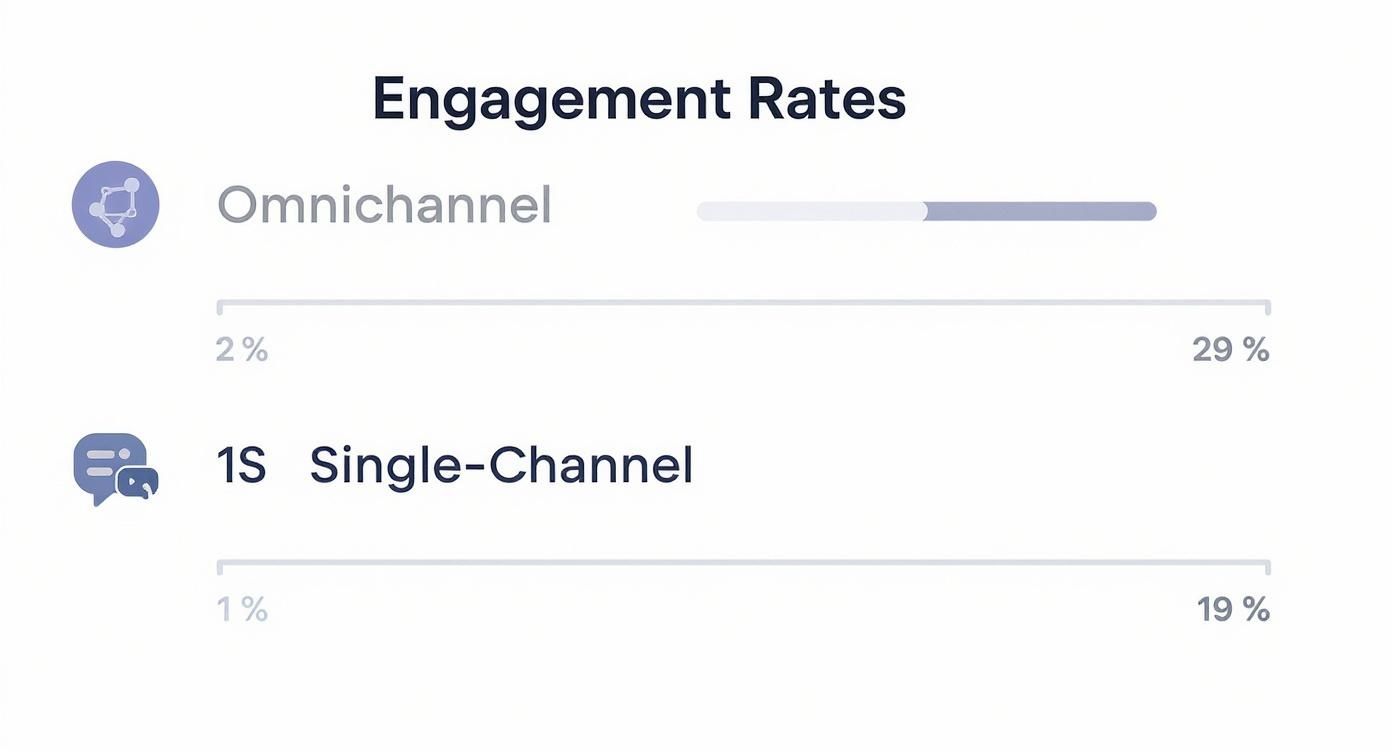
The takeaway is crystal clear: diversifying your outreach channels isn't just a minor tweak. It’s a fundamental shift that can triple your engagement and seriously fill your pipeline.
The numbers back this up, too. B2B companies that go all-in on omnichannel strategies see an average engagement rate of 18.96%. Compare that to just 5.4% for those sticking to one or two channels. That means engaging prospects across multiple platforms—like email, social media, and direct outreach—makes you almost four times more likely to capture and nurture leads effectively.
Automate Your Outreach Without Losing the Human Touch
Trying to manage a sophisticated omnichannel sequence by hand is a recipe for disaster, especially as you scale. This is where automation becomes your secret weapon, letting you execute complex campaigns with perfect consistency.
The key is to automate the process, not the personalization. Your system should handle the scheduling and delivery, but the message itself must feel like it was written by a human, for a human.
Think of it this way: automation ensures the right message hits the right person at the right time. This frees you up to focus on genuine, one-on-one interactions when a prospect finally raises their hand. A good system handles the tedious follow-ups so you never drop the ball. If you're looking to dive deeper, our detailed guide on B2B marketing automation shows you exactly how to set up these powerful systems.
Here’s how to do it right:
- Use smart triggers. Automatically send a follow-up email after someone connects with you on LinkedIn.
- Segment your sequences. Don't send the same messages to everyone. Create different outreach paths based on a prospect's industry, job title, or how they've engaged with you.
- Prioritize personalization tokens. Go way beyond
[First Name]. Use tokens for[Company Name],[Industry], or even a custom line you've written about their latest company news.
By weaving together email, social media, and valuable content into a synchronized system, you build a powerful engine for generating B2B leads. You stop being an interruption and start becoming a trusted resource—ensuring you’re the first person they think of when they're finally ready to talk.
Choose the Right Channels for Your B2B Audience
Figuring out where to spend your time and money is easily one of the most critical decisions you'll make when hunting for B2B leads. Pouring your budget into the wrong channels isn't just a waste; it's a fast track to draining your resources with absolutely nothing to show for it.
The goal isn't to be everywhere. It's to be exactly where your ideal customers are when they start looking for answers.
This means you need a solid framework for picking channels that actually make sense for your industry, your budget, and how your specific audience behaves. That flashy trade show might look impressive, but its astronomical cost could easily sink a startup that would have thrived with a more focused, digital-first game plan.
Assess Your Resources and Audience
Before you can pick your channels, you need to get real about what you have to work with. And I'm not just talking about your marketing budget. It's also about the skills and time your team brings to the table. Got a killer writer who can churn out compelling SEO content? Great. Is your team built for direct, one-on-one outreach? That's a different playbook.
At the same time, you have to go back to your Ideal Customer Profile (ICP). Where do these people actually spend their time?
- Are they senior executives who live and die by industry publications and what their peers are saying?
- Are they technical managers who hang out in niche online forums and Slack communities?
- Do they hit Google the second a problem pops up, or do they scroll through LinkedIn for recommendations?
The answers here will point you straight to your most promising channels. A common reason channel strategies fail is a mismatch between a company's resources and their audience's habits. To get this part right, check out our guide on building an effective B2B channel mix for growth.
Comparing Channel Costs and Effectiveness
Not all lead gen tactics are created equal, especially when you look at the return on investment. The cost per lead (CPL) can swing wildly from one channel to the next, and getting a handle on these differences is essential for building a machine that can last.
Take a look at how some traditional methods are holding up. Cold calling, once the bedrock of B2B sales, now has a success rate of just 2%. A staggering 97% of people just ignore these calls. On the other hand, a well-executed cold email strategy can hit a success rate of 8.5%.
The money tells an even clearer story. Digital tactics like online retargeting and SEO can bring in leads for as little as $31, while big-ticket items like events and trade shows can cost an eye-watering $811 per lead.
To help you visualize these differences, here's a breakdown of how various channels stack up. This isn't about finding the cheapest channel, but about understanding the trade-offs between cost, effort, and the kind of leads you can expect.
B2B Lead Generation Channel Effectiveness Comparison
This data helps frame your decisions. An expensive event might be worth every penny if it gets you in a room with a handful of perfect-fit, high-value enterprise clients. But for generating a consistent, predictable flow of leads, more efficient digital channels are almost always the smarter bet.
Choosing your channels is an exercise in strategic allocation. It's about placing calculated bets on the tactics most likely to deliver qualified leads at a cost your business can sustain.
Striking the Right Balance
The most successful B2B strategies rarely, if ever, lean on a single channel. They build a balanced portfolio of tactics that play off each other's strengths. This approach spreads your risk and creates multiple pathways for potential customers to find their way to you.
Imagine this balanced mix for a B2B SaaS startup:
- SEO and Content Marketing: This is your long game. By creating genuinely valuable content that solves your ICP's biggest headaches, you're building an asset that generates organic leads for years to come. It's incredibly cost-effective but demands patience.
- Targeted Cold Email: This is your direct-response weapon. With a razor-sharp ICP and a compelling offer, you can get straight into the inbox of decision-makers and spark conversations fast. It’s scalable and gives you clear, measurable results.
- LinkedIn Ads (Retargeting): Use this to stay top-of-mind with people who have already shown interest by visiting your website. Retargeting is super efficient because you're talking to a warm audience, keeping your brand visible while they work through their decision.
This trio covers all the bases: inbound interest, proactive outreach, and audience nurturing. It balances long-term brand building with short-term lead gen, creating a much more resilient and predictable system for getting B2B leads.
By carefully analyzing your resources, truly understanding your audience, and making data-backed decisions about channel costs, you can build a powerful strategy that works. This thoughtful approach will help you dodge costly mistakes and create a reliable flow of high-quality leads to fuel your growth.
Turn Your B2B Leads Into Sales Conversations
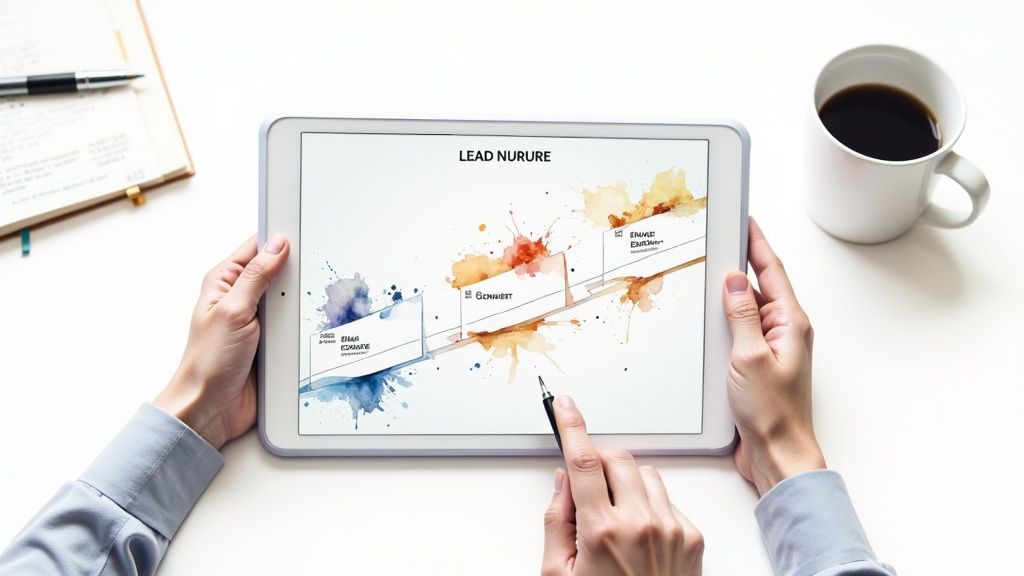
Let's be clear: capturing a B2B lead is a great first step, but it’s the starting line, not the finish. A name and an email address are pure potential, not revenue. The real work—that delicate process of turning a spark of interest into a real, qualified sales conversation—starts now.
A common mistake is teams pushing for a demo or a hard sell way too early. They treat a new lead like they’re ready to buy, when in reality, that person is probably just starting to explore. The teams that consistently win understand this phase is all about building trust and proving your value, not just chasing a quick close.
Design Value-Driven Follow-Up Sequences
Think of your follow-up sequence as your automated ambassador. Its only job is to educate, build your credibility, and stay top-of-mind without ever feeling like spam. The strategy is simple: give, give, give. When you finally ask for something, like a 15-minute call, it feels earned and logical.
This isn't just about sending a few email reminders. It's a curated journey.
- Touchpoint 1 (The Welcome): Right after they download something or sign up, get that welcome email out the door. Deliver the asset, set expectations, and keep it focused on the value they just got.
- Touchpoint 2 (The Insight): A few days later, follow up with a high-value blog post, a quick video tip, or an industry report that builds on their original interest. No sales pitch, just pure value.
- Touchpoint 3 (The Proof): Next, it's time to show them what's possible. Share a compelling case study about a similar company that solved the exact problem they're likely facing. Make the outcome tangible.
- Touchpoint 4 (The Soft Ask): You’ve now provided value three separate times. You've earned the right to ask. Offer something low-commitment, like a "no-pitch strategy session" or an invite to a relevant webinar.
This multi-touch approach positions you as a helpful resource, not just another vendor. To see how this fits into the bigger picture, check out our guide on building a successful B2B sales pipeline to understand how nurturing fuels the entire process.
Implement a Simple Lead Scoring System
Not all B2B leads are created equal. Some are just kicking tires, while others are actively looking for a solution and are ready to talk. A lead scoring system helps your team spot the difference, so they can focus their time on the prospects most likely to convert.
You don't need a complex system to get started. Just assign points based on who they are and what they do.
Who They Are (Firmographic/Demographic):
- Job Title: C-Level/VP (+20), Director/Manager (+10), Specialist/Coordinator (+5)
- Company Size: Matches your ICP (+15)
- Industry: Matches your ICP (+10)
What They Do (Engagement):
- Downloaded a White Paper: +10 points
- Visited the Pricing Page: +25 points
- Opened 3+ Emails: +5 points
- Attended a Webinar: +30 points
Once you have this, set a threshold—say, 70 points—that automatically flips a lead into an "SQL" (Sales Qualified Lead) and pings a sales rep to reach out personally. This data-driven approach means your team is always talking to the hottest prospects first.
Lead scoring transforms your follow-up from a guessing game into a precise science. It allows you to prioritize outreach based on demonstrated interest, dramatically increasing the efficiency and effectiveness of your sales team.
Re-Engage Inactive Leads With Precision
What about the leads who went quiet? Someone who hasn't engaged in 90 days isn't necessarily a lost cause—they might just be busy. A smart re-engagement campaign can bring these forgotten contacts right back into the fold.
Forget the generic "just checking in" emails. One of the most powerful tactics is the "breakup email." It's a final, polite message that acknowledges their silence and offers to close their file. It works surprisingly well.
Here’s a simple framework:
- Acknowledge the situation: "Hi [First Name], I've reached out a few times about [Pain Point] but haven't heard back."
- State your assumption: "I'm assuming this isn't a priority right now, and the last thing I want to do is clutter your inbox."
- The final offer: "If that's the case, I'll go ahead and close your file. If you're still interested, what's the best way to proceed?"
This approach often triggers a response because it introduces a little scarcity and forces a decision. Whether they re-engage or confirm they're not interested, you get a clear answer and can clean up your pipeline. By nurturing new leads, scoring their interest, and re-engaging old ones, you create a dynamic system that consistently turns a contact list into a pipeline of real sales opportunities.
Got Questions? Let's Get Them Answered
Diving into the world of B2B lead generation can feel like you're constantly chasing a moving target. Just when you think you've got a solid plan, a new challenge pops up. That's totally normal.
This section is all about tackling those nagging questions head-on. No fluff, just straight answers to help you fine-tune your strategy and keep that pipeline humming.
How Much Should I Actually Spend on B2B Leads?
There’s no magic number here. How much you should spend really boils down to your industry, how big your average deal is, and how long it takes to close a customer.
A much better way to think about it is by looking at your Customer Acquisition Cost (CAC) and Lifetime Value (LTV). The magic ratio for a healthy B2B SaaS company is aiming for an LTV that's at least 3x your CAC. If you're hitting that 3:1 ratio, you're in a great spot to scale.
If you're just starting out and don't have that data yet, a good rule of thumb is to set aside 15-25% of your target revenue growth for your sales and marketing efforts. Once the data starts rolling in, you can get much smarter, adjusting your spend based on what your CPL and conversion rates are telling you for each channel.
What's the Real Difference Between an MQL and an SQL?
Getting MQLs and SQLs straight is absolutely critical for B2B teams. It’s the official handoff point between your marketing and sales teams, and getting it wrong leads to a lot of friction and missed opportunities.
Marketing Qualified Lead (MQL): This is someone who's shown some interest thanks to your marketing. Maybe they downloaded a white paper, attended a webinar, or signed up for your newsletter. They look like they fit your Ideal Customer Profile, but they haven't raised their hand to say, "I want to buy now."
Sales Qualified Lead (SQL): This is where things get serious. An SQL has been vetted—either by a person or an automated scoring system—and is deemed ready for a direct sales conversation. They've shown clear intent, like requesting a demo, filling out a "contact sales" form, or spending a lot of time on your pricing page.
The jump from MQL to SQL is a huge moment. It's the signal that someone has shifted from just browsing to actively considering a purchase. For your sales team, that's the green light to jump in and start a real, personal conversation.
How Do I Know if My Lead Gen Is Actually Working?
Success isn't just about the number of leads you're generating. You can have a thousand leads, but if none of them turn into customers, you're just spinning your wheels. The real goal is revenue.
To get a clear picture, you need to track the right KPIs for B2B growth. Here are the big three:
- Lead-to-Opportunity Conversion Rate: What percentage of your leads actually become qualified sales opportunities? If you're generating a ton of leads but this number is tiny, you have a lead quality problem, not a lead volume problem.
- Cost Per Lead (CPL) by Channel: This one is huge. You need to know exactly how much it costs to get a lead from LinkedIn Ads versus cold email versus organic search. This data tells you where to double down and what to cut.
- Sales Cycle Length: How long does it take for a new lead to become a paying customer? As your lead generation gets more refined, you should start attracting higher-intent prospects, which will hopefully shorten this cycle over time.
Keeping a close eye on these metrics will help you make smart decisions, optimize your strategy, and prove that your marketing efforts are directly fueling business growth.
At Big Moves Marketing, I specialize in helping B2B SaaS and AI startups build the messaging and sales tools that turn leads into revenue. If you're ready to create a launch strategy that drives adoption and wins deals, let's talk.
%20-%20Alternate.svg)
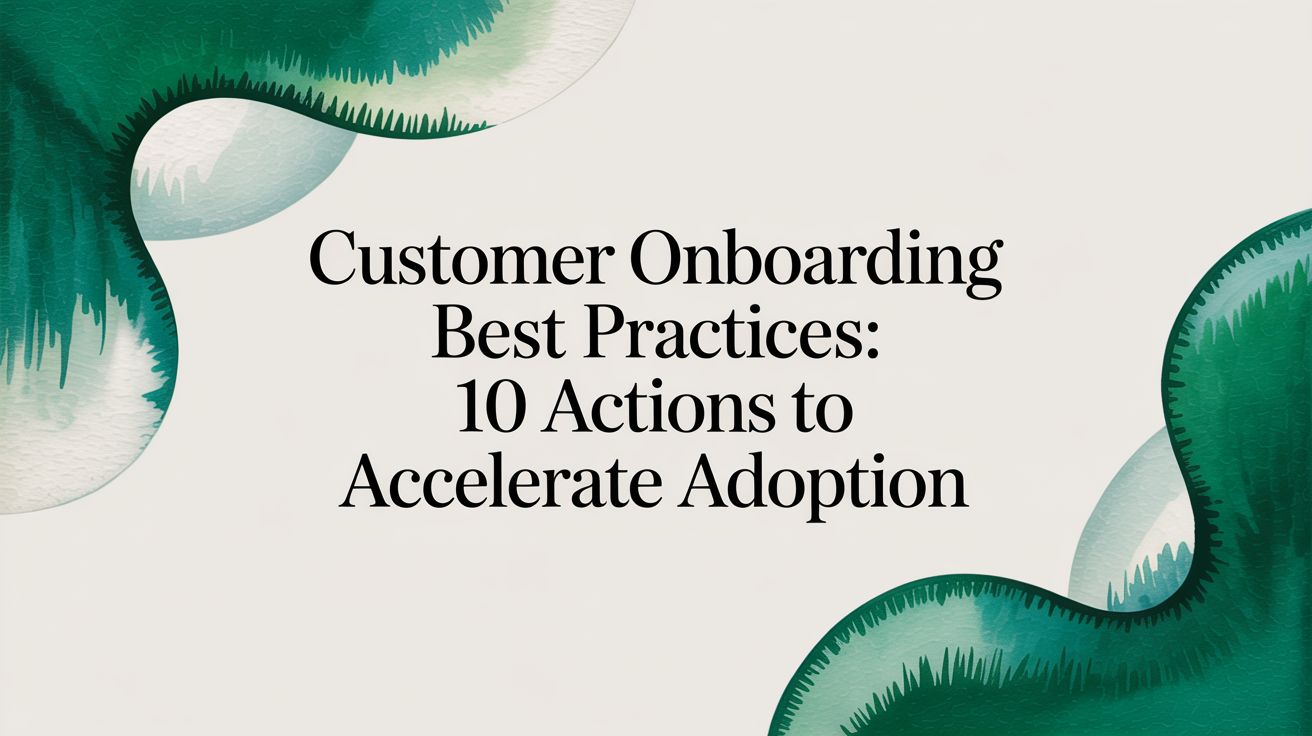

%20-%20white.svg)